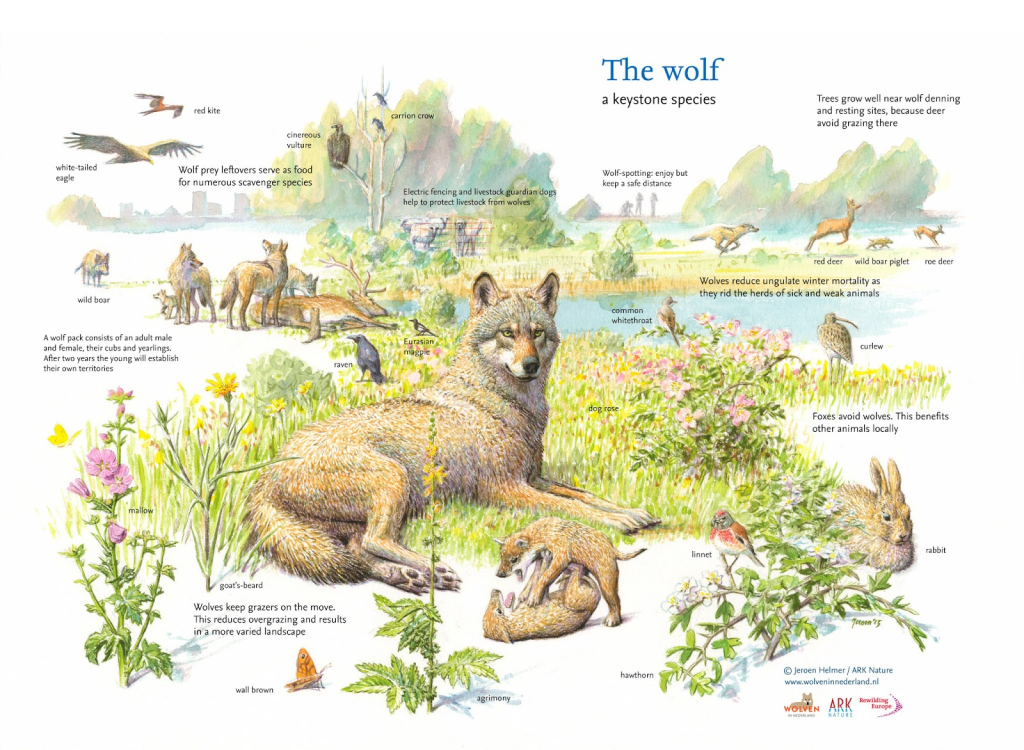A Wilder Nature: How Rewilding Can Help

Next to the climate crisis, there is a huge ecological crisis. More and more biodiversity is lost and this problem will only continue to grow. Rewilding is a method to mitigate this issue, or at least provide a progressive take on traditional nature conservation. It is a way to let nature restore itself and bring back more biodiverse habitats. In this article I will explain what rewilding entails, some examples and where you can find more information on the topic.

What is rewilding?
Initially, rewilding made an introduction as a strategy to increase biodiversity in natural areas and to make these places more ecological resilient. This primary idea was focused on large natural areas, whereas more recent definitions of the concept are more broad.
There are two main focuses that many rewilders seem to adhere to: restoring ecosystems and reducing human control. The first focus is imperative, as ecosystems have been severely damaged and polluted and restoration of habitats is an crucial step to improve biodiversity. The second focus is what makes rewilding unique, as the goal is to create a self-regulating ecosystem where human interference is not necessary to maintain a balanced natural area. Together, these two focuses ensure wilder places where nature takes the lead again.
Keystone species
A big part of rewilding is making sure keystone species thrive. These species are vital for the ecosystem, as they drive the ecological processes that happen. Large herbivores, for example, graze areas and make sure more plant species can grow.
A classic example of trophic rewilding – (re)introducing a species into the area – is the introduction of the wolf in Yellowstone National Park in 1995. This reintroduction resulted in a more balanced ecosystem through the recovery of certain animal and plant species, as well as the restraint of others. Animals like the wolf or the lynx are predators and create a landscape of fear. Deer and other prey animals now have a natural enemy and their behaviour changes. Instead of casually grazing field after field, they now have to be on alert to run away at any moment. This results in more balanced grazing where, for example, more seedlings from willow, cottonwood and aspen could grow bigger. The whole landscape changed because of these predators.
Not only predators can create change in the landscape, animals like the beaver can too. Their dams influence river flow and create new habitats in the water, providing more opportunities for animals and plants alike to thrive. They are called ecosystem engineers as they change the structure of a natural place with their efforts.

More examples of rewilding
I already mentioned thropic rewilding before: introducing species to change the ecosystem. Another example of rewilding is passive rewilding, where you let an area that was previously controlled by humans fully develop itself into a wilder place. This is easily done, and examples of this are areas on the west-coast of Spain where agricultural land is abandoned and forest regrows there, as well as the area of Chernobyl. The latter is a special case, as that area had to be left alone out of necessity, namely after a nuclear disaster. Now, it is a very wild place with a lot of wild horses and plans for this area even include herds of bison.
Sometimes, rewilders may choose to act differently to see if they can enhance the ecosystem, such as flooding a forest in Slovakia. They are aiming to create wetlands, a very important kind of ecosystem that has many benefits, not only for plants and animals, but for humans as well. More about this can be found here.

Europe and The Netherlands
There are many rewilding initiatives in the Netherlands, as well as in the whole of Europe. Following these projects can not only be interesting but more often than not they also need your (monetary) support! Many projects cannot happen without support of the public. Think about issues relating to the reintroduction of predators like the wolf and the lynx. Farmers and others might not be too pleased about having a lynx around. But understanding what it means for the ecosystems if they do return, is a first step.
For more information about various projects that are going on, you can take a look at the following initiatives: Rewilding Europe has many projects going all around Europe, Mossy Earth even has projects in Africa, and ARK Nature focuses on the Netherlands.

I hope you now know a bit more about rewilding and are aware of its importance when it comes to restoring our ecosystems. And maybe you can rewild a small piece of land yourself; even a garden can become wilder!
Sources
https://rewildingeurope.com/rew-project/rewilding-of-the-chernobyl-exclusion-zone/
https://rewildingeurope.com/blog/keystone-species-and-their-role-in-rewilding/
https://www.sciencedirect.com/science/article/pii/S0048969717315929
https://rewildingeurope.com/rewilding-in-action/wildlife-comeback/
